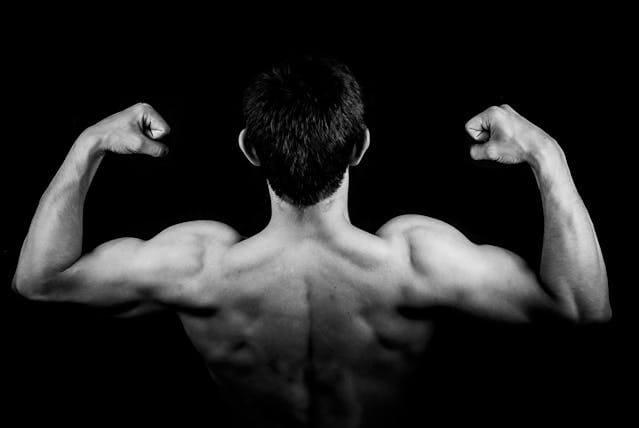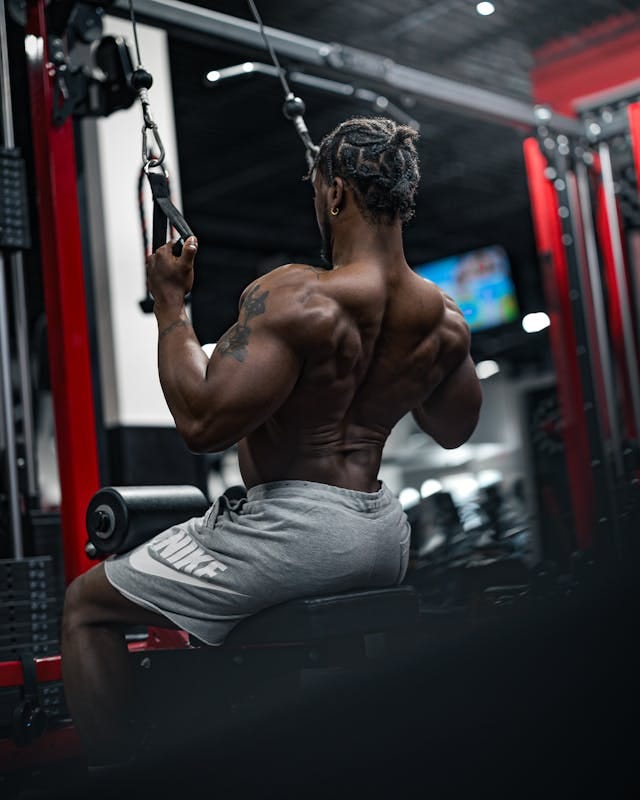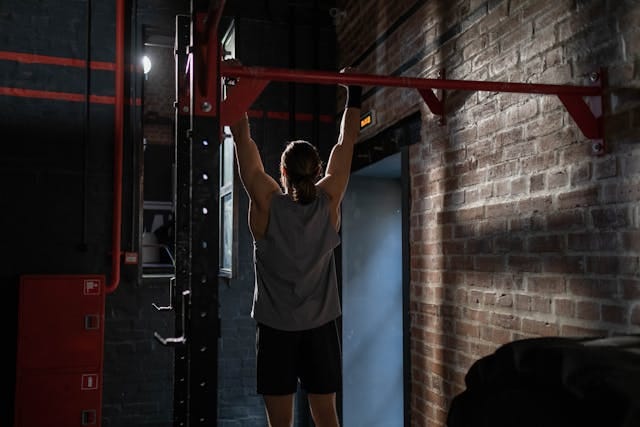Build (Your) Back Better

This is the second in a series of workout articles where I break down the best exercises for each muscle group.
This is to help beginners new to the gym get the most out of their workouts. You’ll learn which exercises to do, how to structure them, and the correct form to use.
Today, we’re focusing on those large upper-body muscles keeping everything supported: back.
Benefits of a strong back include:
- Strength and power - A strong back is the foundation of every heavy lift you perform: squats, deadlifts, rows, overhead press, bench press. They all rely on your back.
- Posture and spinal health - Strong lats, rhomboids, and traps keep your shoulders held back, helping to avoid rounding. It also assists with reducing pressure on your spine, especially in your lower back, preventing injuries and pain.
- Injury prevention - If you have a weak back, your shoulders, hips, and knees need to work harder to compensate. Having a strong back creates stability for your spine and shoulders. This makes you more resilient to muscular imbalances, slipped discs, and rotator cuff injuries.
- Aesthetics - A wide back is at the core of that V-shape physique. Having a strong back adds density and balance to your torso, so it looks like you don’t just train chest and arms.
- Functional strength - Almost all real-world physical activity requires back strength: from climbing to shoveling snow or carrying groceries. Your back is involved in performing everyday tasks of all sizes.
- Athletic performance - Strong backs improve explosiveness, grip strength, and power. This translates to improved performance in almost every sport: tennis, skiing, hockey, golf, football. They all require their top performers to have a strong back.
- Improved breathing and core stability - The muscles around your thoracic spine assist with deep breathing and torso stability. Having a strong back works in tandem with your core to maintain stability under heavy loads.

How do I train my back?
Training your back involves utilizing pulling movements. The angle at which you pull hits different parts of the back.
Needless to say, if you’re on a push-pull-legs routine, your back training is going to fall on your pull day.
Like the chest, some people have a dedicated day for working on their back.
I train my back the same day as chest. I find working the two muscle groups together balance out the training of my torso.
Many of the fundamentals we covered when training chest equally apply to training your back:
- Train your back at least once per week. Twice is preferable.
- Start with a focus on proper form, then begin adding more weight.
- Perform each set to failure - until you cannot perform the exercise with proper form, not until you can no longer move your arms.
- Supersets provide a more intense workout while also saving time. A superset is when you perform sets of two or more exercises back-to-back with minimal rest in between.

What exercises should I do?
There are many back exercises you can do, but for me, the foundation of building a strong back comes down to this one movement:
Pull-ups: This exercise sits at the core of my workout routine. I do them in every back workout.
I consider the pull-up to be the ultimate upper-body exercise, and it doesn’t just target your back.
When you grip the bar, all the muscles starting with your hand’s grip strength, running up your arms, into your shoulders, and across your entire upper back are activated to perform the movement.
If I had to do just one upper-body exercise, it would be the pull-up.
You don’t need weights or fancy equipment, just a bar to hang from.
You can buy cheap, door-hanging pull-up bars. You can also find something to use in a public park, or even a strong tree branch.
Pull-ups are different from chin-ups both in how they’re performed and the muscles they target.
A chin-up is performed with an underhand grip and targets your biceps.
A pull-up is performed with an overhand grip on the bar with your arms just wider than shoulder-width. This emphasizes work on your lats - the muscle that gives your back width.
Pull-ups can be intimidating if you’re just getting started. Don’t feel bad - many people can’t do a single pull-up.
If your gym has an assisted pull-up machine, it’s a great way to get started. Just remember that lowering the weight makes the exercise more difficult.
You can also do band-assisted pull-ups where you loop an exercise band around the bar and step inside the other end with one foot. It’s not something I do, but it’s helped many people work their way up to doing full unassisted pull-ups.
The way I learned how to perform pull-ups stemmed from two other exercises: dead-hangs and negatives.
To perform a dead-hang is pretty simple. You just hang from the bar with both hands and arms extended for as long as you can. It’s great for your posture and strengthens your grip.
This exercise is just as much mental as it is physical. You’ll want to give up and let go much sooner than what your muscles are capable of.
Negatives are like dead-hangs, but kind of the reverse. While standing on the ground or a solid surface, grip the bar and jump to the top portion of a pull-up where your chin is above the bar. Then hang on to that position for as long as you can.
When you lower your body, don’t just fall into a hanging position - struggle against dropping your body every step of the way.
Lower yourself in a slow and controlled manner. Make gravity work to get you.
If you master these two exercises, you’ll soon find that you can perform the first of many pull-ups.
Once you’ve mastered the basic pull-up, you can move on to different variations of this exercise.
- Wide grip pull-ups - emphasizes the lats
- Neutral grip pull-ups - easier on the shoulders, also targets biceps
- Close grip pull-ups - targets lower lats and has extra bicep involvement
- Mixed grip pull-ups - better grip strength and balance, more of a functional variation
- Weighted pull-ups - when bodyweight pull-ups get too easy, get your belt and throw on some weight for additional gains
Remember: when doing pull-ups, don’t just pull with your arms - think about driving your elbows down and back to engage your lats.
Honestly, there are so many positive things I have to say about pull-ups. It really is the best exercise out there for your back.
Don’t skip this exercise just because it’s difficult to get started.

When you’re ready to add more exercises for building that strong back, consider trying some of the following:
- Bent Over Rows - These can be performed with either a barbell or dumbbells. I prefer the barbell. Posture is important with this exercise. Some people perform it slow and controlled, while others use more explosive movements.
When performing rows of any kind, pull with your elbows - not your hands. Driving the elbows back engages the lats.
- T-Bar and Landmine Rows - Similar to the bent over row, only using the landmine attachment or T-bar machine.
- Dumbbell Rows - Also similar to the bent over row, except by using dumbbells and working one side at a time, you’re better able to target each side of your lats.
I often see people doing this exercise wrong - where one leg is bent on top of a bench and the other foot is on the ground. I keep both of my feet on the ground while bending over and hanging on to a bench or a rack for support.
- Seated Rows - You’re using a pulley system or machine for this exercise. I find it easier than the free weight exercises previously listed.
Remember to not round your back too much when doing these.
As for which attachment to use, it depends on what you’re going for:
- Close grip V-attachment - mid-back thickness
- Wide grip bar - upper lats and back width
- Straight bar with underhand grip - lower lats and biceps
- Rope attachment - adds a squeeze to the rear delts and rhomboids at the end of the movement
- Single handle rows - unilateral lat focus and additional stretch to the movement
- Lateral Pulldown - It’s like a pull-up, except you’re held down in your seat and pulling up weights instead of your body.
I like to pair lateral pulldowns with seated rows because the movements are similar, but performed at different angles.
In my gym, there’s a machine where you can do both exercises at the same station making it perfect for supersets.
When you’re performing this exercise, try to keep your back straight and don’t lean too far back in order to properly engage your lats.
Like the seated row, different cable attachments serve different functions: - Wide grip - back width and V-taper
- Middle grip straight bar - balanced lat and back growth
- Underhand grip straight bar - lower lats and biceps
- V-bar - lat thickness and power
- Rope attachment or single handle - isolation, squeeze, and balance
These are all great exercises, but there’s one area we’ve been neglecting: lower back.
Your lower back is the anchor of your posterior chain. Strong erector spinae muscles protect your spine, stabilize heavy lifts, and keep your posture upright.
Neglecting this area leads to poor form with heavy exercises like squats or deadlifts, and poses a higher risk of injury while doing simple tasks like bending over to pick up an object.
You’re going to want to train lower back to avoid back pain, stiffness, and bad posture.
Don’t go too heavy training this area. Focus on proper form, then add weight later on.
Training this part of your back doesn’t need to be extensive or complicated. One or two exercises added to each back workout is enough to keep this part of your body strong.

There are two exercises I usually do:
- Bridges - Most of us spend too much time sitting, and our spines adapt to leaning forward.
This exercise forces the spine to bend in the opposite direction allowing blood flow to reach areas it normally doesn’t.
No equipment needed. Just lay on the floor with your knees bent, and push your body up using your heels.
Hold it for a few breaths, then return your back to the floor.
The next step up from bridge is wheel - where you push off the ground with both your hands and feet.
To a beginner, it looks almost impossible, like it’s an exercise for advanced yogis or gymnasts.
But it’s easier than you think. I found that by training bridge for roughly 3 weeks, I was able to push myself into wheel - at least for a few seconds.
- Lower Back Extensions - Your gym may have a lower back extension machine where you can add weight to the movement.
It may also have a station where you lean against pads and tilt forwards to perform the exercise.
Some of them are set up where you can also do side bends on the same equipment.
This is a great way to target your lower back. You can use your bodyweight or pick up a weight plate for added resistance.
Those two exercises make up the core of my lower back workouts. I’ll usually pick one and do a few sets after my upper back exercises.
That said, there are other exercises that are just as great for targeting lower back.
If you’re looking for more options, consider trying:
- Side bends - These are great for strengthening obliques and quadratus lumborum, preventing imbalances and strengthening rotational stability
- Glute bridges / Hip thrusts - Not just for girls. They build posterior chain strength and protect the spine.
- Supermans - Another bodyweight exercise. Lay flat on your stomach. Then raise your arms, legs and chest off the ground. It’s a safe, beginner-friendly exercise anyone can do.
Sample Workouts:
- Exercise: Number of Sets x Number of Reps
- Take 1 minute rest breaks between each set
- 90 seconds of rest between pull-up sets
- If you can’t do pull-ups yet, perform both the dead-hang and negatives instead
Quick Workout
- Pull-ups: 5 sets to failure
Proper Workout
- Pull-Ups: 5 sets to failure
- Pick One - Bent Over Rows / Dumbbell Rows / T-bar or Landmine Rows: 5 x 8
- Bridges or Lower Back Extensions: 3 x 10
Hardcore Workout
- Pull-ups: 5 sets to failure or 50 pull-ups
- Superset #1 Seated Rows: 8 x 8
- Superset #1 Lateral Pulldown: 8 x 8
- Superset #2 Bridges or Lower Back Extensions: 3 x 10
- Superset #2 Side Bends: 3 x 10 each side

Getting a decent back workout doesn’t need to be complex. With as little as one exercise, you can develop a strong back with a V-taper that drives women wild.
Your back is the engine of the upper body. Training it can be exhausting. Keep it simple, stay consistent, and focus on form. The payoff is a stronger, healthier body that looks just as powerful as it feels.
If you enjoyed this article, bookmark this page and remember to Subscribe - and stay tuned for the next article in this series.
Check out my Substack
And follow me on socials:
Facebook
Twitter
Instagram
Youtube
Thanks for reading.
God Bless.
Member discussion